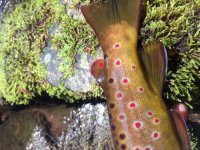troutbert wrote:
outsider wrote:
"It shouldn't be the goal of hatchery managers to "create" the look of wild trout."
Why couldn't or shouldn't this be a seconday or terchiery goal? If they bring a product that is more pleasing to the eye, closer to the color of wild fish, what is the problem?
There isn't a problem, as long as they have a way to clearly mark the [d]wild[/d] [color=0000CC]stocked [/color]trout in a way that distinguishes them from wild trout.
Otherwise, there would be no way to accurately assess trout populations.
And water quality regulations and wetland protections based on streams being assessed as wild trout waters could be easily challenged in court.
The trout can be marked with fin clips.
I thought it was good point too, at first. But lets discuss it a little bit.
I agree that it is important for experts to be able to tell the difference in locations when sampling to determine classification. But certainly not necessary in all or even most cases (IMO). I don't think it would warrant the additional expense of handling and marking every stocked trout.
Sure it would help identify which ones are stocked if they are stocking adult size brown trout over a good wild population, but even then... an expert should be able to tell the difference. And even if they can't, they should be able to adjust accordingly through statistical methods based on the number of fish stocked in that stream, and the number of sub-adult in the sampled population.
Besides, they shouldn't be stocking those anyway.;-)
I think this is also less important for adult rainbow (since there aren't all that many reproducing populations) and adult brook trout (easier to identify a stocked from wild in most cases).
Fingerlings might be a different story; however, the locations where these are stocked are very limited.
And other then trying to determine whether an already known decent stream has improved to class A, how often do they survey stocked streams to determine classification?
Aren't all or nearly all stocked streams classified already?
When looking for streams to add to the natural reproduction list (where this is more important), I think the vast majority are not stocked. Even if a few migrated there it shouldn't be a big issue since I think they are already counting all trout (including stocked) in the overall biomass. And finding only adult trout does not qualify for the designation.
Please consider this as just opinion, and I do find it to be an interesting discussion.





